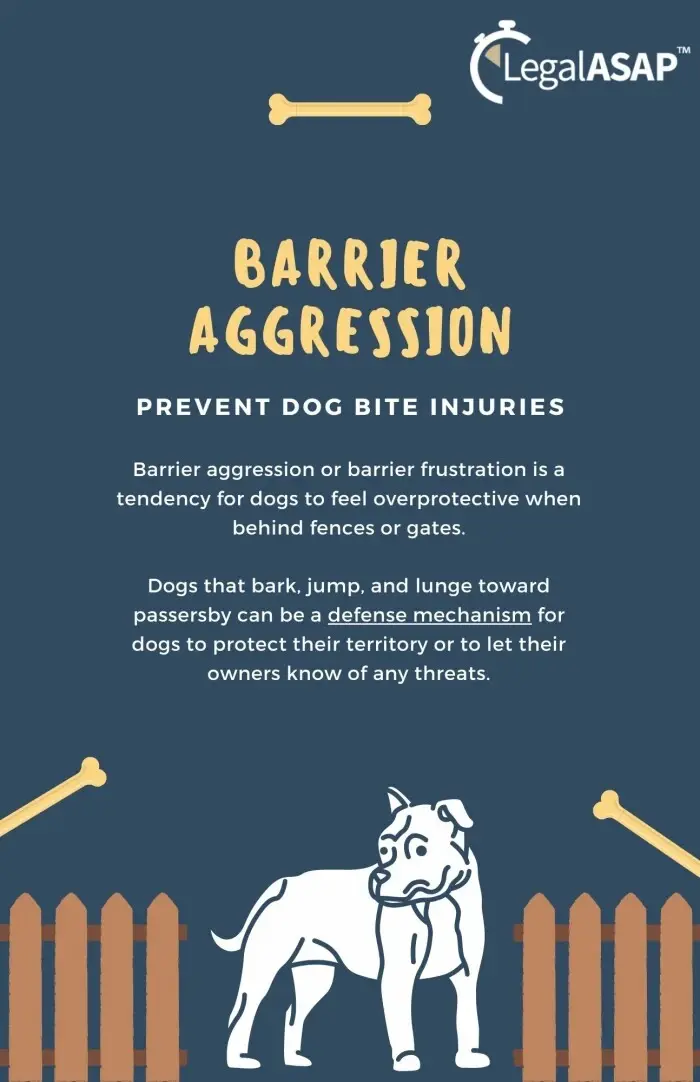Barrier aggression may increase the risk for dog bites as passerby are falsely mistaken as intruders. Dogs could bark, snarl, and lunge at those in response to a stimulus when they are behind gates.
Owners must properly secure their dogs behind a fence to protect public safety. It’s also a courtesy to place a sign to let passers-by know you have a dog on your property. Warning signs like Beware of Dog or Dog on Property can help those walking by be cautious of a dog’s aggressive behavior.
If you or someone you know endured harm by a dog bite injury caused by barrier aggression, seek immediate medical attention. Contact an experienced dog bite attorney to find out the true compensation for your injuries.
Free Personal Injury Evaluation
Weren't at-fault for your accident? Click here to speak with a nearby attorney for FREE about your personal injury claim.
or call (888)-927-3080
What is Barrier Aggression?

Barrier aggression or barrier frustration is a tendency for dogs to feel overprotective when behind fences or gates. Dogs that bark, jump, and lunge toward passersby can be a defense mechanism for dogs to protect their territory or to let their owners know of any threats.
Frequently, a dog may show aggressive behaviors rooted in something much deeper. This is also known as barrier reactivity and is triggered when a dog is aroused by a figure or object moving behind the gate.
Whenever you hear incidents where an overly-territorial dog assaulted a mailman, it most likely occurred due to barrier aggression. Be wary of this behavior, because if the government labels your dog as dangerous, they may issue your dog to be euthanized.
What Causes Barrier Aggression in Dogs?
Dogs develop barrier aggression due to their territorial tendencies and nurtured mannerisms. Suppose a person were to pass by and feel startled due to a dog’s overprotective behavior. The person most likely runs out of fear, reinforcing to the dog that barking prevents passersby from intruding on their territory.
Your dog may have barrier aggression due to increased anxiety from an over-reliance on barriers. A barrier could be anything from gates and fences to leashes and windows. Your dog may act normally without these barriers sustaining them.
If you are unsure your dog has barrier aggression, you can hire a reputable dog trainer or have an animal behaviorist assess your dog’s behavior. It is imperative to observe your dog’s habits to determine the root cause of your dog’s aggressive behavior.
How to Stop Barrier Aggression in Dogs
Having a dog that barks and lunges against the fence towards incoming passersby is not a bad thing if they are defending your home. However, it can pose problems if you have family and friends over who are often the victims of dog bite cases.
To stop barrier aggression in dogs, you can follow the steps below or seek a professional dog trainer.
- Stock in on reward treats. Buy a treat that your dog loves as they can be used as a dog training tool and serve as positive reinforcements.
- Train in a private fenced area. Using a secured see-through fenced area where your dog can freely roam is optimal for training. Give your dogs treats through the fence and observe their behavior.
- Wait for your dog to calm down. If your dog is calm after five seconds or longer, give them a treat. If they act aggressively, turn and walk away. Repeat this training multiple times and gradually increase the amount of time you want them to remain calm.
- Practice in different environments. You can increase the difficulty in training by adding distractions or working in another fenced area.
- Perform recalls. It’s better to teach your dog to come to you whenever you need them by your side. Let your dog roam around the area and whenever they come to you give them a treat. You can say a command like, ‘come back’ after treating them. Repeat the command until they fully understand.
Tips to remember when training your dog:
- Keep training sessions short, about 10 minutes each when you are starting.
- Use treats that your dogs are obsessed with.
- Always remain calm and composed when training them. Use a gentle voice.
- Never punish them physically, and if you feel frustrated, take breaks or try again later.
- If the behavior is caused by multiple stimuli, you’ll need to make each stimulus a training session.
According to the American Veterinary Medical Association, children are more involved in dog bite incidents than adults. The elderly and home servicers like mail carriers are frequent on the list of dog bite victims.
Vulnerable parties are more susceptible to dog bites from owners who exhibit negligence towards the dog training process. The danger only increases when domesticating a pet with a high dog bite force like a Pitbull or German Shepherd.
Placing Proper Fencing
If you are aware of your dog’s barrier aggression, it’s better to place a proper strong fence to prevent them from escaping. Smaller dogs don’t require a taller fence and would be fine with chain link fencing or vinyl fencing if you want to have better-quality fences.
Larger dogs are better suited with aluminum fencing or pressure-treated wood fencing. Tall wood fencing can prevent large dogs that are easily stimulated by movement since there’s no opening to see and prevents them from jumping over. It’s a better choice for dogs who easily bark or snarl at moving figures and objects.
Encountering a Dog With Barrier Aggression
When encountering a dog with barrier aggression, the first thing to do is keep calm and avoid eye contact. If they are behind a fence, it’s easy to walk past them and ignore their barking.
Making direct contact with an aggressive dog exhibiting barrier aggression may come across as threatening.
However, if you come across a dog that is out of their fenced cage, back away slowly. If the dog reacts, stop immediately and don’t move to give the dog more time to calm down.
Do not run, yell, scream, or show fear as that would trigger the dog’s stimuli to react under barrier aggression.
Exchanging Information After a Dog Bite
If you’re injured by a dog bite on someone’s property due to barrier aggression, exchange contact information with the owner. Gather important information for your legal claim like:
- Time and date of accident
- Homeowners or rental insurance information
You may have to call the local animal control authorities after receiving medical care. They will do proper quarantine procedures and determine if the dog is safe for the community.
If the owner was liable for your dog bite, you may have a personal injury claim against them if you hire an attorney. Only through a personal injury lawyer can you receive expert legal advice specific to your case. They can determine how much your legal claim is worth, and whether you have a case to begin with.
Proving Barrier Aggression For Your Dog Bite Claim
After filing a claim with an experienced personal injury attorney, you’ll need to find evidence to prove barrier aggression for your dog bite claim. You can prove that the owner was aware of their dog’s vicious tendencies. Some indicators could include:
- A dog jumping aggressively against the fence;
- A dog barking, snarling, or bearing teeth;
- A dog may have previous history of aggression;
You can also sue for negligence on the owner’s part as long as you can prove the owner was negligent of their pet’s behavior.
Provide proof such as witnesses, photos of the scene, or other materials that prove the aggressive dog’s tendencies. Police reports, medical records, and wage-loss documents can help make your claim a stronger case.
Find a Personal Injury Lawyer to Represent Dog Bite Victims
We understand it’s frustrating and traumatic to handle a dog bite injury and can happen to anyone. This is why finding a personal injury lawyer to represent dog bite victims is important to ensure compensation for your pain and suffering.
Don’t wait on your injury as it could get infectious and hospital bills aren’t cheap.
LegalASAP has a network of over 500+ law firms spread across the United States. We do our best to help connect clients with experienced attorneys in their area. If you’ve experienced a dog bite injury, we can help find a dog bite lawyer to assist you with your case.
Please fill out this free short consultation form, and we will try to reach out as soon as possible.
Cassandra Nguy
Cassandra Tran Nguy is a legal writer living in Los Angeles, California. She graduated cum laude from California State University, Northridge with a B.A. in English Creative Writing and a minor in Marketing. Visit her online profile at linkedin.com


